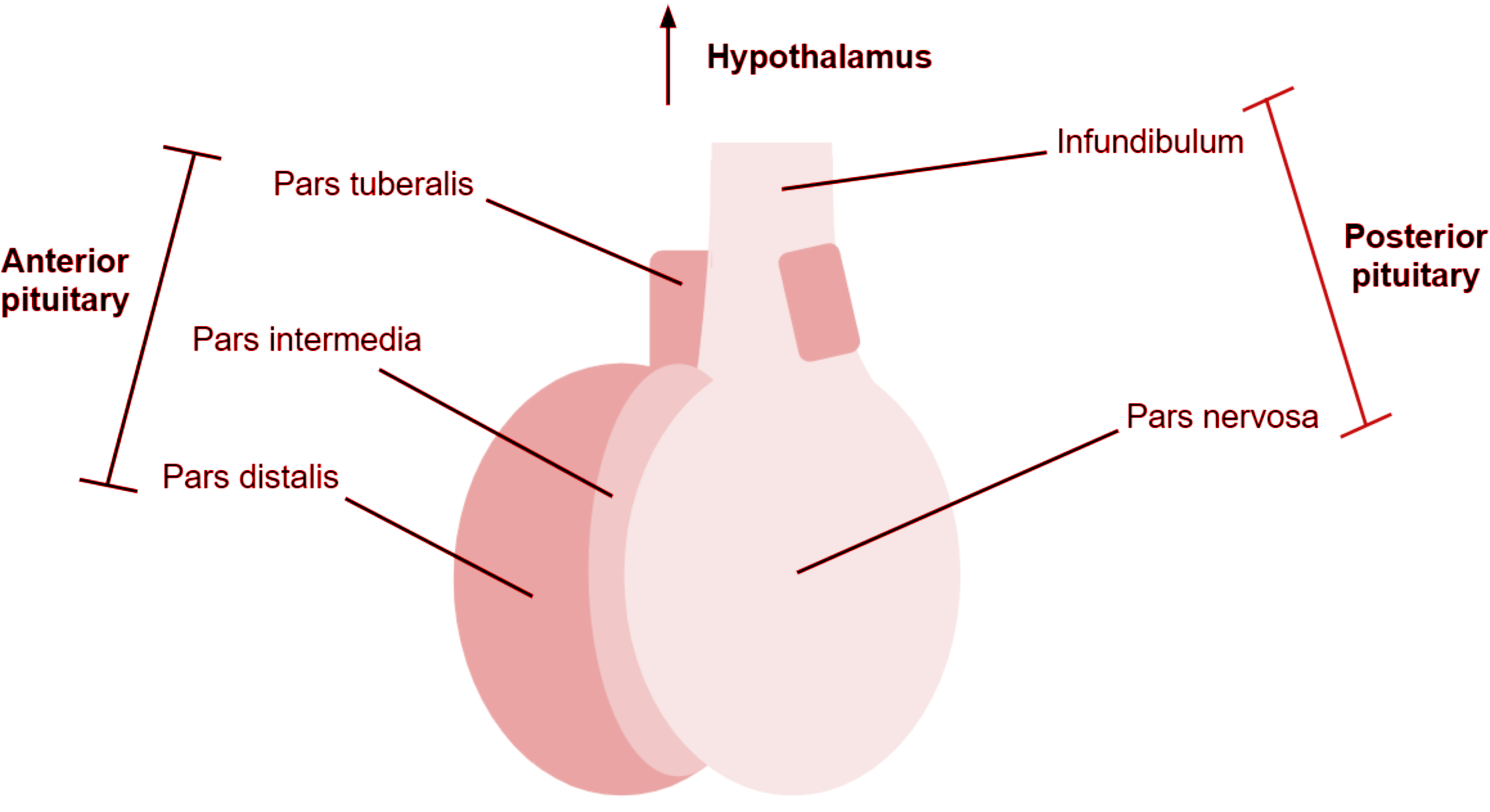
Pars nervosa is a part of
(a) Brain
(b) Spinal cord
(c) Pituitary gland
(d) Pineal gland
Answer
492.3k+ views
Hint: Pars nervosa is also called the neural lobe or posterior lobe. It is the storage site of oxytocin and vasopressin. The two hormones released in the pars nervosa have distinct physiological roles. Oxytocin generates smooth muscles and myoepithelial cell contraction, facilitating uterine contraction during parturition. The pars nervosa originates from the neuroectoderm similarly to the rest of the hypothalamus.
Complete step-by-step answer:
The pars nervosa is a neuroendocrine structure that along with the anterior lobe, intermediate lobe and infundibular stalk make up the pituitary gland. Pituitary or hypophysis is a small gland, seen very closely associated with the brain. It is placed in a depression of sphenoid bone, called sella turcica, and is connected to the hypothalamus of the brain by a stalk- like structure, called infundibular duct. The human pituitary has two lobes, anterior and posterior, known respectively as adenohypophysis and neurohypophysis.

Both these are connected to the hypothalamus. In between, they are the avascular zone, known as pars intermedia. Its role in human beings is rather obscure. Adenohypophysis is hormone- producing. But neurohypophysis only stores and then secretes the hormone produced by the hypothalamus. Adenohypophysis and neurohypophysis are ectodermal in origin. The former is derived from an embryonic invagination of pharyngeal epithelium whereas the latter is derived from an outgrowth of the hypothalamus. The anterior lobe is an endocrine gland and it contains hormone- secreting cells. The posterior lobe is not an endocrine gland.
So, the correct answer is ‘Pituitary gland’.
Additional Information:
- The cell bodies of neurosecretory cells in the hypothalamus produce the hormones oxytocin and vasopressin.
- They are soon transported to the neurohypophysis along nerve fibers by a carrier protein, called neurophysin.
- Although very small in size, the pituitary directly or indirectly controls most of the metabolic activities.
Note:
- The anterior pituitary produces a large number of hormones that regulate the whole range of activities from growth to reproduction and development.
- The release of these hormones is stimulated or inhibited by corresponding hypothalamic hormones, generally called regulating factors.
- These factors constitute a link between the nervous system and the endocrine system. The former stimulates the release of pituitary hormones, and the latter inhibits their release.
Complete step-by-step answer:
The pars nervosa is a neuroendocrine structure that along with the anterior lobe, intermediate lobe and infundibular stalk make up the pituitary gland. Pituitary or hypophysis is a small gland, seen very closely associated with the brain. It is placed in a depression of sphenoid bone, called sella turcica, and is connected to the hypothalamus of the brain by a stalk- like structure, called infundibular duct. The human pituitary has two lobes, anterior and posterior, known respectively as adenohypophysis and neurohypophysis.

Both these are connected to the hypothalamus. In between, they are the avascular zone, known as pars intermedia. Its role in human beings is rather obscure. Adenohypophysis is hormone- producing. But neurohypophysis only stores and then secretes the hormone produced by the hypothalamus. Adenohypophysis and neurohypophysis are ectodermal in origin. The former is derived from an embryonic invagination of pharyngeal epithelium whereas the latter is derived from an outgrowth of the hypothalamus. The anterior lobe is an endocrine gland and it contains hormone- secreting cells. The posterior lobe is not an endocrine gland.
So, the correct answer is ‘Pituitary gland’.
Additional Information:
- The cell bodies of neurosecretory cells in the hypothalamus produce the hormones oxytocin and vasopressin.
- They are soon transported to the neurohypophysis along nerve fibers by a carrier protein, called neurophysin.
- Although very small in size, the pituitary directly or indirectly controls most of the metabolic activities.
Note:
- The anterior pituitary produces a large number of hormones that regulate the whole range of activities from growth to reproduction and development.
- The release of these hormones is stimulated or inhibited by corresponding hypothalamic hormones, generally called regulating factors.
- These factors constitute a link between the nervous system and the endocrine system. The former stimulates the release of pituitary hormones, and the latter inhibits their release.
Latest Vedantu courses for you
Grade 11 Science PCM | CBSE | SCHOOL | English
CBSE (2025-26)
School Full course for CBSE students
₹41,848 per year
Recently Updated Pages
Master Class 11 Economics: Engaging Questions & Answers for Success

Master Class 11 Business Studies: Engaging Questions & Answers for Success

Master Class 11 Accountancy: Engaging Questions & Answers for Success

Master Class 11 English: Engaging Questions & Answers for Success

Master Class 11 Computer Science: Engaging Questions & Answers for Success

Master Class 11 Maths: Engaging Questions & Answers for Success

Trending doubts
State and prove Bernoullis theorem class 11 physics CBSE

1 ton equals to A 100 kg B 1000 kg C 10 kg D 10000 class 11 physics CBSE

State the laws of reflection of light

One Metric ton is equal to kg A 10000 B 1000 C 100 class 11 physics CBSE

1 Quintal is equal to a 110 kg b 10 kg c 100kg d 1000 class 11 physics CBSE

Difference Between Prokaryotic Cells and Eukaryotic Cells




